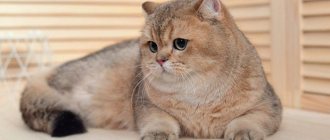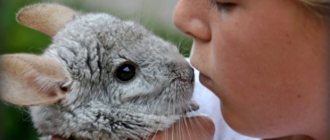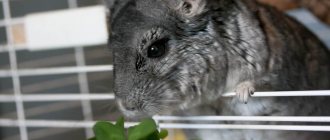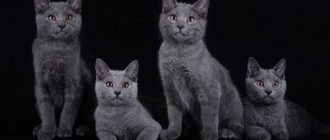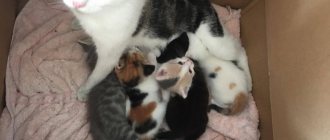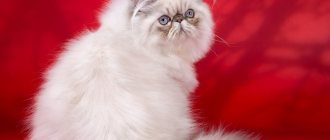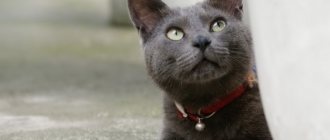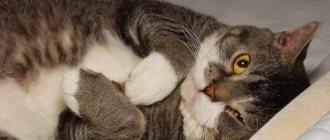Origin story
The Persian chinchilla is a real aristocratic cat.
Graceful features, dignity in every movement, flexible character, rare color - all this makes the breed extremely popular. And not only in the place where the first representatives of Persian chinchillas appeared - in Britain. The story goes that the first Persian chinchilla was born in 1882. Her stuffed animal is still kept in the Natural History Museum under the name “silver lambkin”. Keeping such a breed at home was considered prestigious, so many members of the elite (including relatives of Queen Victoria) lived with these individuals.
If you dig deeper into the history of the appearance of Persian cats in Europe, the following version looks plausible: they were brought from Iran in the 16th century, and having multiplied, they gave birth to a new breed with a wonderful color. The modern name for the breed was assigned in the 20th century, at which time breeders from different countries began to work with the breed. But it is worth noting that the adjustment was minimal.
Standards
This breed is classified as large, since males are able to gain up to 7-8 kg of weight. Females weigh much more modestly: no more than 4.5 kg. Kittens aged 1.5-2 months weigh 600 grams.
| Standard | Description |
| Head | Oval, medium size. The muzzle is round, with expressive features. The forehead, chin and nose are located almost on the same line. |
| Nose | Flat. "Stop" is clear. |
| Eyes | Almond-shaped, large, widely spaced. Iris color: all shades of green. The outline of the eyes is outlined in black, as are the lips. |
| Ears | Small, neatly and widely spaced. Small tassels are visible at the tips. |
| Tail | Short, thick, curvy. The fur on it is 18-20 mm longer than on the rest of the body. |
| Torso | Strong, muscular, elongated. The back is straight. The back is rounded. |
| Limbs | Powerful, but appear short due to the abundance of hair. The paws are round, elastic, the pads are pink, but a dark color is also allowed. |
| Wool | Thick, pleasant to the touch, with a characteristic shine. |
Breeders, in an attempt to improve the breed, crossed Persian chinchillas with British and Persian cats with smoky colors and turquoise eyes. However, the offspring's eye color changed to yellow, which the breeders categorically did not like. Therefore, it was decided that it was best to use exclusively Persian blood.
BRITISH CHINCHILLA KITTENS
British chinchilla kittens are born already chinchilla-colored, but the exact type of color (veiled, shaded, ticked) can only be determined by 3 months. It even happens that British chinchilla kittens “overbloom” and already in adulthood, breed experts change their color, for example, from ticked to shaded or vice versa.
British chinchilla kittens from birth, like all babies, have a bluish cloudy eye color, however, later the eyes change color and a green tint begins to emerge. British chinchilla kittens will acquire rich eye color only by the age of one year. In general, this eye color takes a very long time to develop, up to 2-3 years, and sometimes even up to 5.
Colors
The classic Persian chinchilla has snow-white fur. But there is also a so-called veiled color: when the tips of the hairs are colored and give the coat a certain shade. There may be several of them:
- Black.
- Tortoiseshell (this color is found only in cats).
- Lilac.
- Silver.
- Yellow (or rich apricot).
- Chocolate.
- Striped.
- Smoky.
There are animals with golden tips - the Persian golden chinchilla, as well as the red cameo and cream cameo - the tips are colored cream and red, respectively.
The photo shows a cat of the Persian chinchilla breed. Classic white color, as well as silver and gold
Classic-colored cats have the most pigment in the ears, tail and paws. It has also been noted that the shorter the coat, the brighter the color. Golden chinchillas have a creamy, reddish or milky undercoat, and the hairs at the tips are brown. All together creates a feeling of shimmer on the wool.
Description and breed standard
Chinchilla colors are quite varied, the most popular and in demand are silver, gold and silver shaded. There are also tabby, tortoiseshell, marbled, harlequin, bicolor, cinnamon and fawn colors.
- The British Golden Chinchilla has a rare peach coloration with a dark undercoat. The rims around the mucous membranes are brown. Not all wool is the same golden color. The beauties have a more reddish back, sides, and tail, while the neck and belly are more creamy.
- The British Silver Chinchilla has an incredible coat with a silver tint and black highlighting on the back, legs, head and tail. According to the standard, a black veil on a silver chinchilla can cover no more than 80% of the body.
- If more than a third of the British coats are black, the breed is called silver-shaded. The dark paws and nose contrast beautifully with the white fur.
Character and behavior
Persian chinchillas are real phlegmatic people: calm, measured, imperturbable, but sociable and friendly. A turbulent life with endless bustle and the search for adventure is alien to representatives of this breed. The sweetest thing for them is to find themselves a cozy, warm place, on a soft sofa or windowsill, and hum a song to themselves while watching what is happening next to them.
But it is a mistake to think that little Persians are not able to play! Like any cats, “chinchillas” love to play with strings, chase a ball rolled out of paper, and hunt around the corner for a bow on their owner’s slipper.
However, all this is the innocent fun of a cute animal and will never develop into wild races throughout the apartment with overturning floor vases, hanging on curtains and scratching the owner’s furniture while meowing victoriously. “Chinchillas” rarely speak, preferring to communicate with their eyes (therefore, owners of breeding females should carefully monitor the onset of estrus themselves).
Persians get along with both adults and children. And of all ages. You can safely leave even very young children with them: Persians do not use their claws and teeth, preferring to resolve conflicts quietly and peacefully. In extreme cases, they will simply run away to some secluded place where the child cannot reach him.
What breeds do you prefer?
ShorthairLonghair
The Persians are too flexible to be the first to go into conflict, and too lazy to hunt. And it would seem that there are no obstacles to the appearance of other animals in the house. Yes, there are no obstacles, and you can easily get a couple of rodents or parrots.
But other dogs and cats make Persians nervous: large animals give them a sense of danger, small animals make them jealous. And if you get an active animal that won’t give your “chinchilla” peace, it will begin to turn into an unsociable person and may even get sick and start fighting with it! Therefore, remember: placing someone with adult Persians is fraught with a lot of problems. If your dog and cat grew up together, there will be no problems.
This does not apply to cats of the same breed. Persians get along well side by side, probably due to their 100% similarity in character. By the way, breeders recommend getting your Persian a girlfriend or boyfriend even if you are a busy person and cannot pay enough attention to your pet, or often leave home.
Persians quickly get used to their new home and easily tolerate moving and changing surroundings. Leaving them at home, you can be sure that when you return, you will not find any damage. The main thing is not to forget to leave the cat a few toys. Kittens do not need company, while adults rarely play on their own, preferring to lie in the sun and doze.
Persians are not averse to taking a walk in a park or other quiet place where grass grows. Therefore, immediately accustom your kitten to a harness.
These cats are touchy and very sensitive. Do not raise your voice at them, even if they do something wrong, otherwise they will get scared and stop trusting you.
Persian chinchillas are not the most expensive breed, but the cost depends on the pedigree, litter and other factors. The average cost of a kitten is 20,000 rubles.
Castration and sterilization of British chinchillas
At what age is it recommended to have surgery?
The procedure is done upon reaching 8 months. Before the operation, a consultation with a veterinarian is necessary, who will examine the pet and make a conclusion about its health.
Caring for your pet after surgery
After the castration operation is completed, your pet must be constantly monitored. Competent care consists of the following points:
- Limit physical activity.
- Ensure silence in the house.
- Do not give food for 8 hours after removal of the genitals.
- Purchase and put a special collar on the animal to avoid licking the wound.
- Regularly treat the seam with hydrogen peroxide.
Care instructions
There are a lot of difficulties in caring for Persian chinchillas.
Wool
The main attention, of course, is paid to their coat. Beautiful, shiny and long fur quickly turns into a matted dull “something” without proper care. Therefore, you will have to comb your cat every day, using both a slicker brush and a special wide-tooth comb. The process begins with the tummy, chest and hind legs, then the head, back, hindquarters and tail are processed: in the direction of hair growth first, then against the growth.
Bathing
You need to bathe your animal either when it gets dirty or once every 2-3 months. Human shampoos and gels are not suitable: after licking off the remains, the cat will develop severe intestinal upset. Therefore, purchase the necessary products at the pet store - “Detangling Celandine”.
If your dog is categorically against bathing, is overly nervous and worried, reduce the number of baths to a minimum and, if possible, use dry shampoo, and wipe particularly dirty areas with wet wipes.
Animals that participate in exhibitions require special care. Tinted detergents allow you to give its appearance a special shine and will not allow a light fur coat to turn yellow.
Eyes
The Persian's eyes also require constant monitoring. The flattened muzzle of the Persian leads to the fact that the animal from an early age begins to suffer from constant lacrimation (the eye canal is poorly formed). There is a high risk that pathogenic bacteria will get into the eyes and inflammatory processes will begin.
Therefore, wash your cat’s eyes with special eye drops (you can use warm, freshly brewed chamomile infusion or saline solution) and a cotton swab.
Ears
The ears are wiped with a damp cotton sponge once a week. Nails are trimmed with the same frequency. True, many Persians know how to sharpen them on their own, and they do not need your help. Teeth are brushed once every 2 weeks with a special toothbrush and cat paste. Once a year it is worth paying for ultrasonic tartar removal.
It is best to clean the cat's litter box immediately after the cat has gone to the toilet. Filler – silica gel or wood shavings. Once a month, pour boiling water over the tray.
In the photo there is a cat of the Persian chinchilla breed
Features of care and maintenance
Owners of golden chinchilla cats have to comb their luxurious coat at least 2 times a week to keep it tidy. During the molting period, the procedure is carried out daily.
Chinchillas have a two-layer coat. It must be combed in 2 stages: first along the hair growth, then against it. It is recommended to use a fine-toothed comb or a special glove.
Cats are bathed as needed, but not more than once every 3-4 months. Due to frequent washing, the coat becomes dry and brittle. Dry products are used as a replacement for regular shampoos.
Otherwise, care for golden chinchillas is standard:
- are vaccinated annually;
- regularly treated against fleas, ticks and worms;
- Clean your ears every week;
- rub your eyes daily;
- trim the claws as they grow (about once a month);
- taken to the veterinarian for preventive examinations.
The pet should have a separate place to rest, a variety of toys and a cat scratching post. Animals quickly learn to use the toilet, but the tray must be large and comfortable, since the golden chinchilla color is found in fairly large breeds.
For your information. Some cats like to walk on a leash or harness. However, most of them are satisfied with being in a confined space - a house or apartment.
Catering
The tendency towards obesity and kidney pathologies suggests that the menu for your pet should be prepared with special care. If you feed him too much fatty food or too much protein, he will become lazy and quickly gain weight. And this is a direct path to disease.
You can feed the Persian chinchilla both natural and commercial food. But for each type there are certain rules that you should follow.
Natural products
The following foods can be included in the Persian diet:
- Lean meat: veal, beef, poultry (chicken, turkey), rabbit. Before serving, the meat is doused with boiling water to destroy parasite eggs.
- Offal: raw chicken hearts, boiled liver, finely chopped necks.
- Sea fish, shrimp, squid.
- Eggs: chicken and quail. Quail can be given raw, chicken is boiled and only the yolk is given.
- Fermented milk products: cottage cheese, sour cream, natural yogurt without preservatives and dyes, cream, fermented baked milk, kefir, unsalted cheese.
- Cereals: buckwheat, oatmeal, millet, rice. Porridge is boiled in water, a little milk is added for taste. Liquid semolina porridge is fed to kittens up to 3 months.
- Vegetables: pumpkin, carrots, zucchini, asparagus, herbs (dill, parsley, green salad), cucumbers.
- Sprouted wheat.
The cat's bowl should always be filled with clean water at a comfortable temperature. Bottled or settled - it doesn’t matter, but pouring from the tap is not recommended. Change it twice a day: morning and evening.
It is forbidden to give cats:
- Alcohol, sparkling water, juices, coffee, tea.
- Avocado, eggplant, grapes.
- Dried fruits.
- Peas, chickpeas, lentils.
- Sausage, wieners, frankfurters.
- Offal, bones, fat, lard.
- Whole milk.
- Sweets, baked goods, flour, fried.
- Smoked, salted, fatty.
- Human canned food.
- Spices, sauces, mayonnaise, seasonings.
Expert opinion
Dusheba Vera Ivanovna
In 2010, she graduated from the Moscow State Academy of Veterinary Medicine named after K.I. Scriabin with honors, specializing in veterinary medicine. I regularly attend veterinary conferences, congresses, and webinars.
Since Persians are prone to urolithiasis, you should not pamper your cat with fish more than once a month.
Recommended food
Industrial food (both dry and wet) can save a lot of time if you don’t like or can’t prepare your cat’s food yourself. Modern holistic and super-premium foods have a balanced composition and a sufficient amount of vitamins and microelements necessary for the development of a cat.
In the photo there are kittens of the Persian chinchilla breed
List of holistic foods: Farmina N&D, Gather, Power of Nature.
Expert opinion
Dusheba Vera Ivanovna
In 2010, she graduated from the Moscow State Academy of Veterinary Medicine named after K.I. Scriabin with honors, specializing in veterinary medicine. I regularly attend veterinary conferences, congresses, and webinars.
Forget about economy-class food: they contain practically no useful additives or meat. And without these components, the product turns into empty “chewing gum.” In addition, they often cause allergies.
Super premium food: Airi, Arden Grange, Naturea, Pronature Life.
Below are recommended super-premium foods. Links with the names of the food are clickable, on them you can, within our website, get acquainted with the descriptions of the food and read reviews from owners of Persian chinchilla cats.
| Super Premium | Super Premium | Holistic |
| Meowing Heads | Leonardo | PureLuxe |
Diseases
Following basic hygiene rules will reduce the risk of your pet contracting some dangerous diseases. When you come from the street, wash your hands immediately. Do not approach the cat in outerwear. The same applies to shoes: they can easily bring pathogens from the street. First of all, this applies to cats that have not yet been vaccinated.
A peculiarity of Persians is snoring during sleep. This is a feature of the body associated with congenital deformation of the nasal septum, so do not panic.
- Eye infections occur frequently in Persians. The treatment method is chosen by the veterinarian: in some cases medication is sufficient, in others only surgery will help.
- Polycystic kidney disease is the formation of cysts on the organ. Causes kidney failure. Maintenance therapy is recommended.
- Gingivitis and periodontitis are also quite common. If the disease is advanced, only tooth extraction will help.
- The special structure of the nasal passages leads to frequent colds. The cat should be protected from hypothermia: do not allow it to sit in a draft, dry its fur with a hairdryer after bathing, do not feed food from the refrigerator, and do not walk in bad weather.
- Hypertrophic cardiomyopathy is a thickening of the heart muscle. The cat begins to get tired quickly, cough, breathe heavily and moves little. It is impossible to cure the disease, but drug maintenance therapy can significantly alleviate the condition and prolong life.
- Dermatitis is characterized by the appearance of brown discharge around the nose and eyes. The hair in these areas falls out, the skin turns red and swells, which is why the cat experiences discomfort and constantly tries to scratch this area. It often spreads to the ears. Occurs mainly in young animals. Medicines can achieve remission, but without proper control the disease develops again.
Diseases of chinchilla cats
These beautiful creatures are quite strong and hardy, but have a predisposition to certain diseases:
- polycystic kidney disease;
- excessive tearing;
- retinal atrophy;
- hypertrophied cardiomyopathy;
- due to the special structure of the nose, breathing problems may occur;
- obesity;
- dental problems;
- tendency to skin diseases.
Treatment should be carried out by a veterinarian. At best, home therapy simply won't help. Problems can be avoided by basic attention to the health of your chinchilla beauty and careful care of her, especially her coat and eyes.
Chinchilla cats are purchased for exhibitions, but their value is not only in their impeccable beauty. By their very presence they are able to create an atmosphere of comfort and peace in the house. The aristocratic beauty is very smart, intelligent, affectionate, has a good disposition, and gets along with children and animals.
